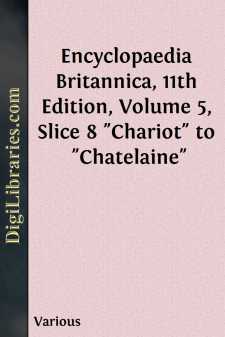Categories
- Antiques & Collectibles 13
- Architecture 36
- Art 48
- Bibles 22
- Biography & Autobiography 813
- Body, Mind & Spirit 142
- Business & Economics 28
- Children's Books 17
- Children's Fiction 14
- Computers 4
- Cooking 94
- Crafts & Hobbies 4
- Drama 346
- Education 46
- Family & Relationships 57
- Fiction 11829
- Games 19
- Gardening 17
- Health & Fitness 34
- History 1377
- House & Home 1
- Humor 147
- Juvenile Fiction 1873
- Juvenile Nonfiction 202
- Language Arts & Disciplines 88
- Law 16
- Literary Collections 686
- Literary Criticism 179
- Mathematics 13
- Medical 41
- Music 40
- Nature 179
- Non-Classifiable 1768
- Performing Arts 7
- Periodicals 1453
- Philosophy 64
- Photography 2
- Poetry 896
- Political Science 203
- Psychology 42
- Reference 154
- Religion 513
- Science 126
- Self-Help 84
- Social Science 81
- Sports & Recreation 34
- Study Aids 3
- Technology & Engineering 59
- Transportation 23
- Travel 463
- True Crime 29
Encyclopaedia Britannica, 11th Edition, Volume 5, Slice 8 "Chariot" to "Chatelaine"
by: Various
Publisher:
DigiLibraries.com
ISBN:
N/A
Language:
English
Published:
1 year ago
Downloads:
14
Categories:
*You are licensed to use downloaded books strictly for personal use. Duplication of the material is prohibited unless you have received explicit permission from the author or publisher. You may not plagiarize, redistribute, translate, host on other websites, or sell the downloaded content.
Description:
Excerpt
CHARIOT(derived from an O. Fr. word, formed fromchar, a car), in antiquity, a conveyance (Gr.á¼â¦ρμα, Lat.currus) used in battle, for the chase, in public processions and in games. The Greek chariot had two wheels, and was made to be drawn by two horses; if a third or, more commonly, two reserve horses were added, they were attached on each side of the main pair by a single trace fastened to the front of the chariot, as may be seen on two prize vases in the British Museum from the Panathenaic games at Athens. On the monuments there is no other sign of traces, from the want of which wheeling round must have been difficult. Immediately on the axle (á¼âξων,axis), without springs of any kind, rested the basket or body (δïφρος) of the chariot, which consisted of a floor to stand on, and a semicircular guard round the front about half the height of the driver. It was entirely open at the back, so that the combatant might readily leap to the ground and up again as was necessary. There was no seat, and generally only room for the combatant and his charioteer to stand in. The pole (á¿¥υμÃÅς,temo) was probably attached to the middle of the axle, though it appears to spring from the front of the basket; at the end of the pole was the yoke (ζυγὸν,jugum), which consisted of two small saddles fitting the necks of the horses, and fastened by broad bands round the chest. Besides this the harness of each horse consisted of a bridle and a pair of reins, mostly the same as in use now, made of leather and ornamented with studs of ivory or metal. The reins were passed through rings attached to the collar bands or yoke, and were long enough to be tied round the waist of the charioteer in case of his having to defend himself. The wheels and body of the chariot were usually of wood, strengthened in places with bronze or iron; the wheels had from four to eight spokes and tires of bronze or iron. This description applies generally to the chariots of all the nations of antiquity; the differences consisted chiefly in the mountings. The chariots of the Egyptians and Assyrians, with whom the bow was the principal arm of attack, were richly mounted with quivers full of arrows, while those of the Greeks, whose characteristic weapon was the spear, were plain except as regards mere decoration. Among the Persians, again, and more remarkably among the ancient Britons, there was a class of chariot having the wheels mounted with sharp, sickle-shaped blades, which cut to pieces whatever came in their way. This was probably an invention of the Persians; Cyrus the younger employed these chariots in large numbers. Among the Greeks and Romans, on the other hand, the chariot had passed out of use in war before historical times, and was retained only for races in the public games, or for processions, without undergoing any alteration apparently, its form continuing to correspond with the description of Homer, though it was lighter in build, having to carry only the charioteer....











